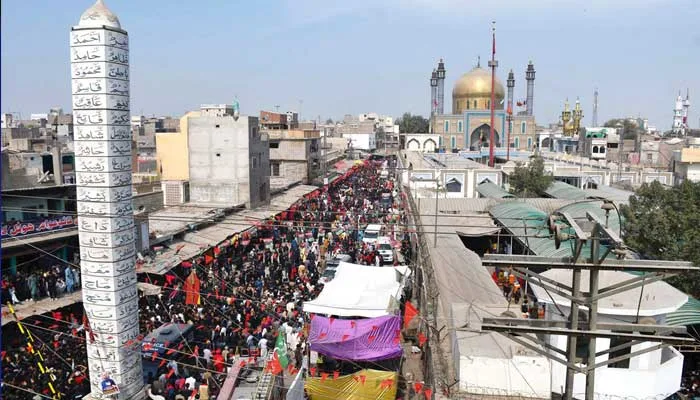In the heart of Sehwan Sharif, where the echoes of devotion blend with the rhythmic beats of dhamaal, lies the sacred resting place of one of the most revered Sufi saints of all time—Hazrat Lal Shahbaz Qalandar (may Allah bless him). His life was a journey of unwavering faith, divine wisdom, and miraculous occurrences, inspiring generations beyond borders and beliefs.
A Birth Foretold in Divine Dreams
Long before the world knew him as Lal Shahbaz Qalandar, he was Hazrat Syedna Sheikh Usman Marwandi, born in the 12th century in the region of Marwand (present-day Afghanistan). His father, Hazrat Syedna Kabiruddin (may Allah bless him), was a devout scholar. According to legend, before his birth, Hazrat Kabiruddin had a dream in which Imam Hussain (may Allah be pleased with him) foretold the birth of a child destined to spread divine love and wisdom. The dream was a celestial announcement of the arrival of a spiritual luminary.
The Making of a Saint
From an early age, young Usman exhibited an extraordinary inclination toward spirituality. He memorized the Holy Quran at a tender age and delved deep into Islamic sciences, Sufism, and philosophy. Guided by some of the most prominent scholars and saints of his time, he mastered the intricacies of divine wisdom. Yet, a restless spirit burned within him, pushing him to seek deeper truths beyond the confines of scholarly discussions.
The Journey of Enlightenment
Driven by an insatiable thirst for divine knowledge, Hazrat Usman Marwandi traveled extensively. He visited Karbala, the sacred land of sacrifice, where he further absorbed the spiritual teachings of the Ahle-Bayt. He later journeyed through Persia, Central Asia, and the Indian subcontinent, meeting renowned mystics and scholars, refining his spiritual path with each encounter.
During his travels, he became known as “Shahbaz” (royal falcon), a title symbolizing his spiritual strength and ability to soar above worldly desires. It is believed that Imam Hussain (may Allah be pleased with him) had bestowed this title upon him in another divine vision witnessed by his father.
Read: 773rd Urs of Lal Shahbaz Qalandar Underway in Sehwan
Arrival in Sindh: A Land Awaiting His Light
His travels eventually led him to Sindh, a land marred by socio-political turmoil but ripe for spiritual awakening. In Sehwan, he established his khanqah (spiritual center), where people from all walks of life gathered to seek solace and enlightenment. The destitute, the outcasts, and the seekers of truth found a sanctuary in his presence.
His teachings were not limited to words; they were actions that spoke louder. Through his deep devotion to Allah, he healed the sick, fed the hungry, and shattered the chains of discrimination. His presence alone was enough to transform hearts, and his miracles, or karamat, became the whispers of divine grace among his followers.
The Misconception About His Attire
The title ‘Lal’ (meaning red) was given to him due to his spiritual radiance and his association with divine wisdom. However, a common misconception exists that he used to wear a red robe because of this title. In reality, there is no historical evidence that Hazrat Lal Shahbaz Qalandar wore red attire.
Islamic teachings clearly state that wearing pure red clothing is discouraged for Muslim men, as mentioned in authentic Hadith. Saints and pious figures like him adhered strictly to the principles of Shariah. The belief that he wore red is a misinterpretation based on his title rather than historical facts.
The Miracles that Defined His Legacy
His life was adorned with miracles that deepened the faith of his followers. One of the most famous stories tells of a scorching summer when he handed his miswak (toothstick) to a disciple and instructed him to plant it in the dry land. By dawn, the miswak had transformed into a lush tree, providing shade to weary travelers.
Another tale speaks of how, during a time of severe drought, he prayed fervently, and rain poured down, reviving the barren lands. His spiritual insight was so powerful that even those who plotted against him found themselves humbled by his divine radiance.
The Eternal Flight of Shahbaz
On the 21st of Sha’ban, 673 AH (1274 CE), Hazrat Lal Shahbaz Qalandar left the mortal world, yet his spiritual presence never faded. His shrine in Sehwan Sharif remains a sanctuary of love and devotion, drawing millions of devotees who seek blessings and solace. The dhamaal—an ecstatic form of Sufi dance performed in his honor—continues to symbolize the boundless energy of his teachings.
A Legacy Beyond Time
Hazrat Lal Shahbaz Qalandar’s life was not merely a story of miracles but a testament to the transformative power of faith, love, and devotion. He taught that spirituality transcends rituals and resides in the purity of one’s heart and the service of humanity. His message of unity, tolerance, and divine love remains as relevant today as it was centuries ago.
As the shrine echoes with the soulful chants of Dama Dam Mast Qalandar, his spirit soars, a falcon in the realm of eternity—forever guiding, forever illuminating.
Follow us on Google News, Instagram, YouTube, Facebook,Whats App, and TikTok for latest updates
